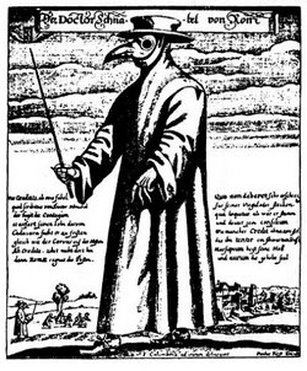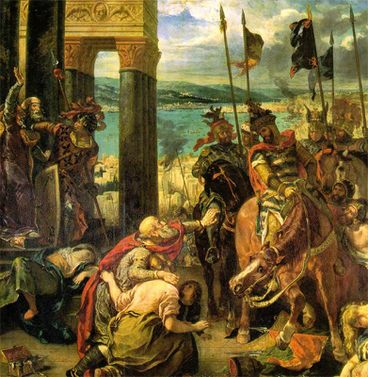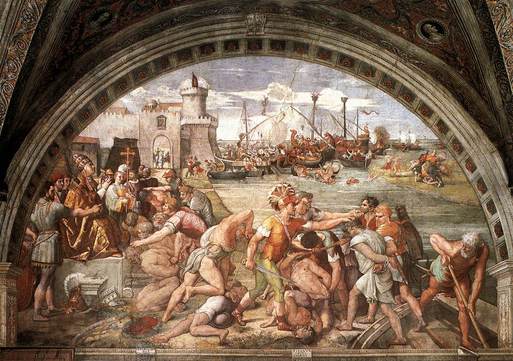I. Activating Prior Knowledge
What is an epidemic? How does an epidemic impact the lives of the people who are ill and the people who survive?
II. Setting A Purpose for Reading
The Black Plague struck terror in the hearts of all people during the Middle Ages. As you read, take note of the symptoms of the Bubonic Plague. How would you have reacted if a member of your family would have started showing these symptoms?
III. Reading the Text (Read, Re-Read, and Read Again)
Giovanni Boccaccio, Italian writer from Florence wrote this description of the plague in an introduction to The Decameron.
The Signs of Impending Death
"The symptoms were not the same as in the East, where a gush of blood from the nose was the plain sign of inevitable death; but it began both in men and women with certain swellings in the groin or under the armpit. They grew to the size of a small apple or an egg, more or less, and were vulgarly called tumours. In a short space of time these tumours spread from the two parts named all over the body.
STOP! Can you answer this question? If not, go back and re-read the passage.
What were the signs of the Bubonic Plague? How long did it take for it to spread?
Soon after this the symptoms changed and black or purple spots appeared on the arms or thighs or any other part of the body, sometimes a few large ones, sometimes many little ones. These spots were a certain sign of death, just as the original tumour had been and still remained. No doctor's advice, no medicine could overcome or alleviate this disease, An enormous number of ignorant men and women set up as doctors in addition to those who were trained. Either the disease was such that no treatment was possible or the doctors were so ignorant that they did not know what caused it, and consequently could not administer the proper remedy.
STOP! Can you answer this questions? If not, go back and re-read the passage.
Why did doctor's have difficulty treating the Black Plague?
In any case very few recovered; most people died within about three days of the appearance of the tumours described above, most of them without any fever or other symptoms.
Source: http://www.historywiz.com/primarysources/blackdeath.html
IV. Personal Reflection – Respond to the following questions in your blog. Be sure to include a quote from the text to support your response.
Part 1 - Response: What evidence in the text best illustrates the impact of the Black Plague?
Part 2 - Response: How did the Black Plague affect life throughout Europe and the Middle East? What problems might have arose for the people who survived?
V. Peer Reflection - Read three classmates’ response and respond to what they have written.
What is an epidemic? How does an epidemic impact the lives of the people who are ill and the people who survive?
II. Setting A Purpose for Reading
The Black Plague struck terror in the hearts of all people during the Middle Ages. As you read, take note of the symptoms of the Bubonic Plague. How would you have reacted if a member of your family would have started showing these symptoms?
III. Reading the Text (Read, Re-Read, and Read Again)
Giovanni Boccaccio, Italian writer from Florence wrote this description of the plague in an introduction to The Decameron.
The Signs of Impending Death
"The symptoms were not the same as in the East, where a gush of blood from the nose was the plain sign of inevitable death; but it began both in men and women with certain swellings in the groin or under the armpit. They grew to the size of a small apple or an egg, more or less, and were vulgarly called tumours. In a short space of time these tumours spread from the two parts named all over the body.
STOP! Can you answer this question? If not, go back and re-read the passage.
What were the signs of the Bubonic Plague? How long did it take for it to spread?
Soon after this the symptoms changed and black or purple spots appeared on the arms or thighs or any other part of the body, sometimes a few large ones, sometimes many little ones. These spots were a certain sign of death, just as the original tumour had been and still remained. No doctor's advice, no medicine could overcome or alleviate this disease, An enormous number of ignorant men and women set up as doctors in addition to those who were trained. Either the disease was such that no treatment was possible or the doctors were so ignorant that they did not know what caused it, and consequently could not administer the proper remedy.
STOP! Can you answer this questions? If not, go back and re-read the passage.
Why did doctor's have difficulty treating the Black Plague?
In any case very few recovered; most people died within about three days of the appearance of the tumours described above, most of them without any fever or other symptoms.
Source: http://www.historywiz.com/primarysources/blackdeath.html
IV. Personal Reflection – Respond to the following questions in your blog. Be sure to include a quote from the text to support your response.
Part 1 - Response: What evidence in the text best illustrates the impact of the Black Plague?
Part 2 - Response: How did the Black Plague affect life throughout Europe and the Middle East? What problems might have arose for the people who survived?
V. Peer Reflection - Read three classmates’ response and respond to what they have written.



 RSS Feed
RSS Feed